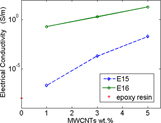Article contents
Investigation of epoxy resin/multiwalled carbon nanotube nanocomposite behavior at low frequency
Published online by Cambridge University Press: 01 December 2014
Abstract

In this work, the electrical characterization of nanocomposites made of epoxy resins with multiwalled carbon nanotubes is presented. As the filler, two different types of multiwalled carbon nanotubes with different aspect ratios (280, 1250) and defectiveness were selected. The production procedure, the morphological characterization, the I–V DC characteristics, and the low frequency complex permittivity (in the range 100 kHz–12 MHz) of these nanocomposites are discussed. To investigate the dispersion of the solution, a study which linked the mixing time to the zeta potential was performed. The experimental results show that with the same matrix and by using the same measurement techniques, the two nanocomposites give different results and can be correlated with the characteristics of nanotubes. The dc conductivity of the nanocomposites was measured by means of a two-point probe technique. The conductivity in the frequency range 100 KHz–12 MHz was evaluated using a circular disk capacitor and measuring the impedance. The measured conductivity follows a percolation scaling law of the form σ ∝ (p − p c)t . A best fit to the measured conductivity data was obtained and the values of the exponent t compared to those in the literature.
- Type
- Articles
- Information
- Journal of Materials Research , Volume 30 , Issue 1: Focus Issue: Soft Nanomaterials , 14 January 2015 , pp. 101 - 107
- Copyright
- Copyright © Materials Research Society 2015
References
REFERENCES
- 14
- Cited by


